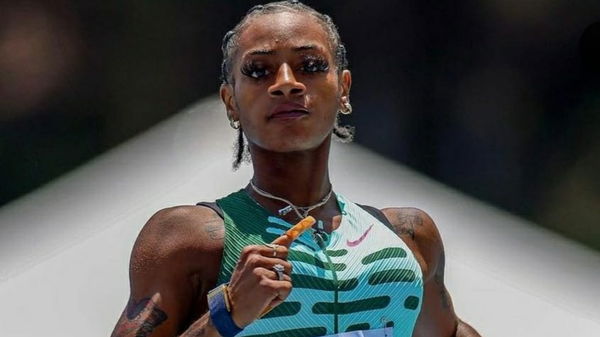Equestrian at Tokyo Olympics 2021: All Show Jumping Rules and Other Details

Follow Us

Equestrian in the Tokyo Olympics 2021 features three unique sports. From dressage to eventing to show jumping, every sport has its fanbase and talented athletes. The most recognisable but not so popular sport in equestrian is show jumping. Let’s look at the rules and structure of this historical sport.
Show jumping at the Tokyo Olympics 2021

via Getty
HACHIOJI, JAPAN – APRIL 14: Tokyo 2020 Olympic Games mascot Miraitowa poses with the Olympic Symbol after unveiling ceremony on Mt. Takao to mark 100 days before the start of the 2020 Tokyo Olympic Games on April 14, 2021 in Hachioji, Tokyo, Japan. (Photo by Kim Kyung-Hoon – Pool/Getty Images)
The sport show jumping is exactly what it’s called, a horse-rider combination leaping over a set of obstacles. Introduced to the Olympics in 1900, this sport has grown into an enjoyable experience for both athlete and viewer. No particular horse breed is better in show jumping than others, making it a level playing field.
ADVERTISEMENT
Article continues below this ad
However, few teams and legends have dominated this sport.Germany’s Hans Günter Winkler and Italy’s Raimondo and Piero D’Inzeo are three of the most successful athletes in show jumping. Currently, Germany’s Daniel Deusser leads the jumping world rankings, but only has one Olympic bronze to his name. He will gun for gold to maintain his position as the world #1.
Trending

Dale Jr Unmasks Teresa Earnhardt’s Refusal to Sell Him His Late Father’s Prized Possession That Forced Relocation Move
April 17, 2024 12:29 PM EDT

After Team USA’s Defence for Nike, Sha’Carri Richardson and Athing Mu Flaunting Different Olympic Outfits Resurfaces
April 16, 2024 08:22 PM EDT

Masters Horror Lands Jon Rahm & Co in Deep Trouble as Stubborn Greg Norman Refuses to Compromise
April 15, 2024 07:45 PM EDT

“Don’t Come for My Family”: Simone Biles Shuts Down ‘Divorce’ Demands With Jonathan Owens
April 17, 2024 01:58 PM EDT

Roger Federer Breaks Partnership With Billion Dollar Worth Italian Brand Days After Coco Gauff’s Stunning Commercial Appearance
April 12, 2024 07:23 PM EDT
Get instantly notified of the hottest Olympics stories via Google! Click on Follow Us and Tap the Blue Star.

Follow Us

via Getty
CANNES, FRANCE – JUNE 09: Jessica Springsteen competes at International Longines Global Champion Tour – Day 1 on June 9, 2016 in Cannes, France. (Photo by Jacopo Raule/Getty Images)
The star-studded US show jumping team features not just three former medalists but a young world champion with a huge mainstream following. Jessica Springsteen, McLain Ward, Laura Kraut and Kent Farrington will look to continue the US dominance in show jumping.
Attire for show jumpers is very similar to dressage riders. An ASTM/SEI helmet with a harness is a compulsory item, along with a choker/stock tie, tall boots (spurs are optional), red/black jackets and light-colored breeches.
Structure of show jumping at the Tokyo Olympics 2021
For the show jumping competition at the Tokyo Olympics 2021, team and individual competitions run separately. The individual competition begins first and goes on for two days. The first day serves as a qualifier with 75 rider-horse combinations tackling a course with twelve to fourteen obstacles. All combinations go through the same course, after which the top 30 advance to the individual final.
At the individual final, the combinations tackle a different course with more obstacles. The winner is the athlete who racked up the least penalty points. In case of a tie, the athletes will compete in a jump off, where both athletes go through the course again with the fastest timing winning.
The team competition also begins with a qualifier where 20 teams begin. The top ten teams move on to the finals, where the winner is based on the accumulated number of penalty points.
Rules and scoring for show jumping
ADVERTISEMENT
Article continues below this ad
The rules for show jumping are straightforward, unlike eventing and dressage. The athlete-horse combination with the least penalty points racked up qualifies for the finals, and the same method determines the winner. But what are penalty points in the first place?
Penalty points apply when a combination breaks a rule and include various types. Jumping penalties apply when a horse refuses to jump over and obstacle or knocks it down. Time penalties apply when a combination does not finish the course within the given time frame. A combination penalty applies when a horse refuses a series of obstacles, requiring the rider to begin from the start.
Four faults or penalty points apply for jumping penalties while timing penalties lead to one penalty point applied for every late second. For example, if a combination completes a set in 62 seconds, two seconds over the given 60 second limit, two penalty points will apply. If they complete it in 62.3, three penalty points will apply as time penalties apply to even a fraction of a second.
ADVERTISEMENT
Article continues below this ad
Although the rules seem stringent, the FEI has done a magnificent job in stratifying show jumping.

Tokyo Olympics 2021: Three Debutantes Who Could Steal the Show in Equestrian
